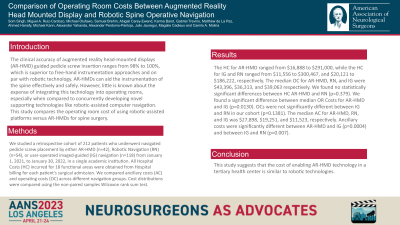Comparison of Operating Room Costs Between Augmented Reality Head Mounted Display and Robotic Spine Operative Navigation
Friday, April 21, 2023


Samuel N. Brehm, BSME (he/him/his)
Medical Student
Washington University School of Medicine
Corpus Christi, Texas, United States
ePoster Presenter(s)
Introduction: The clinical accuracy of augmented reality head-mounted displays (AR-HMD) guided pedicle screw insertion ranges from 98% to 100%, which is superior to free-hand instrumentation approaches and on par with robotic technology. AR-HMDs can aid the instrumentation of the spine effectively and safely. However, little is known about the expense of integrating this technology into operating rooms, especially when compared to concurrently developing novel supporting technologies like robotic-assisted computer navigation. This study compares the operating room cost of using robotic-assisted platforms versus AR-HMDs for spine surgery.
Methods: We studied a retrospective cohort of 212 patients who underwent navigated pedicle screw placement by either AR-HMD (n=42), Robotic Navigation (RN) (n=54), or user-operated imaged-guided (IG) navigation (n=118) from January 1, 2021, to January 30, 2022, in a single academic institution. All Hospital Costs (HC) incurred for 18 functional areas were obtained from Hospital billing for each patient’s surgical admission. We compared ancillary costs (AC) and operating costs (OC) across different navigation groups. Cost distributions were compared using the non-paired samples Wilcoxon rank sum test.
Results: The HC for AR-HMD ranged from $16,888 to $291,000, while the HC for IG and RN ranged from $11,556 to $300,467, and $20,121 to $186,222, respectively. The median OC for AR-HMD, RN, and IG were $43,396, $36,313, and $39,063 respectively. We found no statistically significant differences between HC AR-HMD and RN (p=0.379). We found a significant difference between median OR Costs for AR-HMD and IG (p=0.0130). OCs were not significantly different between IG and RN in our cohort (p=0.1381). The median AC for AR-HMD, RN, and IG was $27,898, $19,251, and $11,523, respectively. Ancillary costs were significantly different between AR-HMD and IG (p=0.0004) and between IG and RN (p=0.007).
Conclusion : This study suggests that the cost of enabling AR-HMD technology in a tertiary health center is similar to robotic technologies.
Methods: We studied a retrospective cohort of 212 patients who underwent navigated pedicle screw placement by either AR-HMD (n=42), Robotic Navigation (RN) (n=54), or user-operated imaged-guided (IG) navigation (n=118) from January 1, 2021, to January 30, 2022, in a single academic institution. All Hospital Costs (HC) incurred for 18 functional areas were obtained from Hospital billing for each patient’s surgical admission. We compared ancillary costs (AC) and operating costs (OC) across different navigation groups. Cost distributions were compared using the non-paired samples Wilcoxon rank sum test.
Results: The HC for AR-HMD ranged from $16,888 to $291,000, while the HC for IG and RN ranged from $11,556 to $300,467, and $20,121 to $186,222, respectively. The median OC for AR-HMD, RN, and IG were $43,396, $36,313, and $39,063 respectively. We found no statistically significant differences between HC AR-HMD and RN (p=0.379). We found a significant difference between median OR Costs for AR-HMD and IG (p=0.0130). OCs were not significantly different between IG and RN in our cohort (p=0.1381). The median AC for AR-HMD, RN, and IG was $27,898, $19,251, and $11,523, respectively. Ancillary costs were significantly different between AR-HMD and IG (p=0.0004) and between IG and RN (p=0.007).
Conclusion : This study suggests that the cost of enabling AR-HMD technology in a tertiary health center is similar to robotic technologies.
